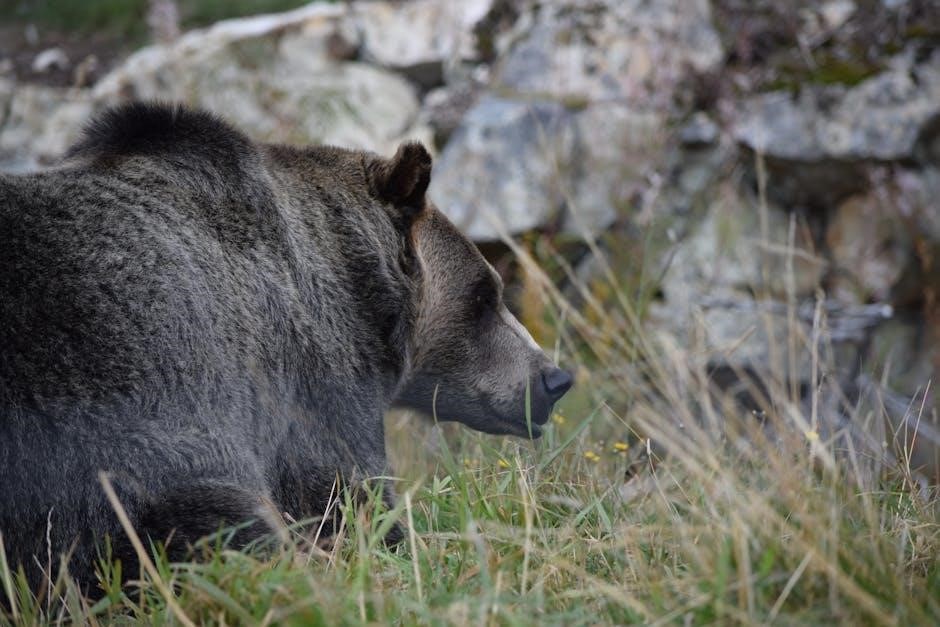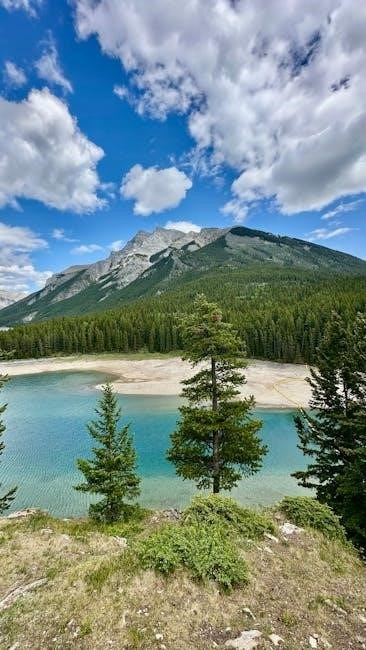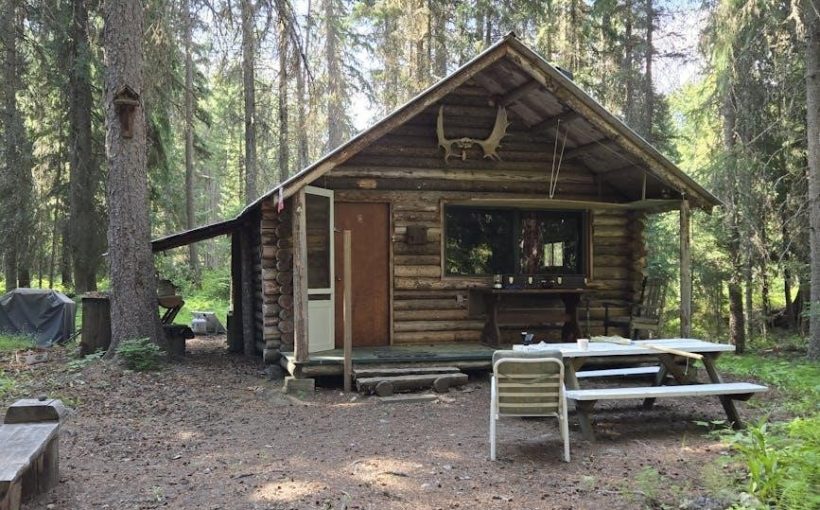Discover the convenience of Canada trivia questions and answers in PDF format, offering a comprehensive and engaging way to explore Canada’s diverse history, culture, and geography.
Overview of Canada Trivia
Canada trivia encompasses a wide range of engaging and informative questions about the country’s history, geography, culture, and notable figures. These questions are designed to test knowledge and spark curiosity, covering topics from the nation’s vast landscapes to its vibrant cities. With diverse difficulty levels, Canada trivia caters to both casual learners and enthusiasts. It’s often used in educational settings, quizzes, and casual games, making it a fun way to explore Canada’s unique identity. The questions highlight key facts, such as provinces, capitals, and iconic landmarks, while also delving into lesser-known details. Whether for personal growth or group activities, Canada trivia offers an entertaining and educational experience.
Importance of Canada Trivia Questions
Canada trivia questions hold significant educational and cultural value, fostering knowledge about the nation’s rich history, diverse geography, and vibrant culture. These questions encourage active learning, making complex information accessible and engaging. They are particularly useful in classrooms, promoting student engagement and understanding of Canada’s heritage. Additionally, trivia questions enhance cognitive skills like memory and critical thinking. They also serve as a tool for social interaction, making them ideal for group activities and events. By exploring Canada through trivia, individuals gain a deeper appreciation of its unique identity and contributions to the world.
Benefits of Using PDF Format for Trivia
The PDF format offers unmatched convenience for Canada trivia questions and answers, providing a downloadable and printable resource. This ensures easy access to trivia content anytime, anywhere, without requiring internet connectivity. PDFs are also environmentally friendly, as users can print only what they need. Additionally, the format preserves the layout and design, ensuring a professional and visually appealing presentation. This makes it ideal for educational purposes, group activities, or personal learning. The ability to share PDFs effortlessly across devices further enhances their utility, making them a practical choice for diverse settings, from classrooms to casual gatherings.

Geography of Canada
Canada’s vast geography features expansive mountains, forests, lakes, and coastlines, making it the world’s second-largest country by land area. Its diverse landscape highlights its natural beauty and significance.
Provinces and Territories of Canada

Canada is divided into 10 provinces and 3 territories, each with unique cultural and geographical characteristics. The provinces include Ontario, Quebec, British Columbia, Alberta, Saskatchewan, Manitoba, Nova Scotia, New Brunswick, Prince Edward Island, and Newfoundland and Labrador. The territories are Yukon, Northwest Territories, and Nunavut. These regions vary in size, population, and economic contributions, from the densely populated Ontario to the vast, sparsely inhabited Nunavut. Understanding Canada’s provinces and territories is essential for grasping its political structure, natural resources, and cultural diversity. This knowledge is often tested in trivia questions, making it a key area of focus for enthusiasts of Canadian geography.
Capital Cities and Their Significance
Canada’s capital cities hold significant historical, political, and cultural importance. Ottawa, the federal capital, is renowned for landmarks like Parliament Hill and the Rideau Canal. Provincial capitals, such as Toronto, Vancouver, and Quebec City, each reflect their region’s unique identity. These cities are hubs for government, economy, and culture, shaping Canada’s national identity. Trivia questions often highlight these capitals, testing knowledge of their roles and landmarks, making them a popular topic in Canadian trivia.
Canada’s Largest Cities and Their Economic Impact
Canada’s largest cities are key drivers of its economy, innovation, and cultural diversity. Toronto, as the financial hub, hosts the Toronto Stock Exchange and major banks. Vancouver excels in trade and technology, while Montreal thrives in aerospace and cultural industries. Calgary is central to the energy sector, particularly oil and gas. These cities attract investment, foster innovation, and create employment opportunities. Trivia questions about these cities often focus on their economic roles, making them a fascinating topic for exploring Canada’s urban significance and its impact on the nation’s growth and global standing. Their contributions shape Canada’s modern identity and prosperity.

Canada’s Natural Wonders and Landmarks
Canada boasts an array of stunning natural wonders and iconic landmarks, each with unique features that captivate visitors and trivia enthusiasts. Niagara Falls, a breathtaking spectacle, is one of the world’s largest waterfalls. The Canadian Rockies, including Banff and Jasper National Parks, offer pristine mountain vistas and diverse wildlife. The Aurora Borealis, or Northern Lights, light up the night skies in northern regions like Yukon and Aurora Village. These natural marvels are often featured in trivia questions, highlighting Canada’s rich environmental heritage and its importance in global tourism. Exploring these landmarks through trivia provides insight into their significance and allure.
Time Zones in Canada
Canada spans six time zones, showcasing its vast geographical expanse. From Pacific Time (PT) in the west to Newfoundland Time (NT) in the east, each zone reflects regional diversity. Mountain Time (MT), Central Time (CT), Eastern Time (ET), and Atlantic Time (AT) complete the list. Most regions observe daylight saving time, except some areas like most of Saskatchewan. Understanding these time zones is essential for trivia enthusiasts, offering insights into Canada’s spatial layout and regional variations. This knowledge enhances appreciation of the country’s sprawling landscape and its impact on daily life, making it a fascinating trivia topic.
History of Canada
Canada’s rich history spans Indigenous cultures, European exploration, and nation-building. Key events like Confederation in 1867 shaped its identity, blending traditions and forging a unique national story.
Indigenous Peoples and Their Role in Canadian History
Indigenous Peoples have played a vital role in shaping Canada’s history, contributing to its cultural, social, and economic development. Their resilience and traditions have been vital barometers of Canada’s identity. Many Indigenous communities continue to preserve their languages, customs, and lands despite historical challenges. European colonization and policies like residential schools profoundly impacted their lives. Today, Indigenous Peoples are key contributors to Canada’s modern identity, advocating for reconciliation and rights. Their influence is evident in art, governance, and environmental stewardship, making them an integral part of Canada’s diverse tapestry.
Explorers and the Discovery of Canada
Explorers played a pivotal role in shaping Canada’s history, with European voyages sparking its discovery. Jacques Cartier and Samuel de Champlain were key figures, mapping coastal regions and establishing French settlements. The Vikings, led by Leif Erikson, are believed to have reached Canada centuries earlier, settling at L’Anse aux Meadows. Indigenous Peoples welcomed early explorers, sharing knowledge of the land. These interactions laid the groundwork for future colonization and cultural exchange. The explorers’ journeys unveiled Canada’s vast natural resources and diverse landscapes, setting the stage for its transformation into the nation it is today.
Key Historical Events Shaping Canada
Canada’s history is marked by pivotal events that shaped its identity and development. The Battle of Vimy Ridge in 1917 symbolized Canada’s emergence as a nation. Confederation in 1867 established the Dominion of Canada, uniting provinces under a federal system. The Great Depression and World War II profoundly impacted the nation, fostering social change and economic growth. The Quiet Revolution in the 1960s transformed Quebec’s cultural and political landscape. The patriation of the Constitution in 1982, including the Canadian Charter of Rights and Freedoms, solidified national autonomy. These events collectively define Canada’s journey toward becoming the diverse and resilient nation it is today.
Canada’s Centennial Year and Its Significance
Canada’s Centennial Year in 1967 marked a milestone in its history, celebrating 100 years since Confederation. The year was filled with nationwide celebrations, including the Expo 67 in Montreal, which showcased Canadian innovation and culture. The centennial symbolized national pride and unity, with events highlighting Canada’s diverse heritage. It also brought attention to the country’s development and future aspirations. The Centennial Baby, born on July 1, 1967, became a symbolic representation of Canada’s future. This year remains a significant moment in Canadian history, reflecting on past achievements and envisioning the nation’s progress.

Political Structure of Canada
Canada’s political structure is a federal parliamentary democracy with a constitutional monarchy. The Prime Minister leads the government, while provinces and territories have their own legislatures.
Canada’s Government System
Canada operates as a federal parliamentary democracy and a constitutional monarchy. The Queen serves as the head of state, represented by the Governor General, while the Prime Minister is the head of government. The government is divided into federal and provincial jurisdictions, with powers outlined in the Constitution Act. The federal government oversees national matters like defense and foreign policy, while provinces manage education, healthcare, and local affairs. The bicameral legislature includes the Senate and the House of Commons, with Senators appointed and Members of Parliament elected. This system ensures a balance of power and representation, fostering unity across Canada’s diverse provinces and territories.
Provincial Flags and Their Meanings
Each Canadian province and territory has a unique flag that reflects its history, culture, and identity. For instance, Quebec’s flag, the first to be officially adopted, features the fleur-de-lis, symbolizing French heritage. New Brunswick’s flag incorporates the Union Jack and the provincial flower, the violet, representing its British roots and natural beauty. Ontario’s flag includes the Red Ensign with the Union Jack and the fleur-de-lis, signifying its historical ties to both France and Britain. These flags are not just symbols of regional pride but also vital elements of Canada’s national identity, showcasing the country’s diversity and shared history.
Official Languages and Bilingualism in Canada
Canada is a bilingual nation, officially recognizing both English and French as its two official languages. This linguistic duality is rooted in the country’s history, with British and French colonization shaping its cultural identity. Bilingualism is a cornerstone of Canadian governance, ensuring that federal services and communications are accessible in both languages. New Brunswick is the only officially bilingual province, while Quebec is predominantly French-speaking. Indigenous languages also hold significance, with many government services available in these languages across various regions. This linguistic diversity reflects Canada’s commitment to inclusivity and cultural harmony, fostering a sense of unity through shared language policies. Bilingualism is not just a legal requirement but a celebration of Canada’s multicultural identity.
Canada’s National Symbols and Their Importance
Canada’s national symbols are deeply rooted in its history and culture, reflecting the country’s identity and values. The maple leaf, prominently featured on the Canadian flag, is a cherished symbol of national unity and pride. It represents Canada’s vast natural landscapes and the unity of its diverse population. The beaver, Canada’s national animal, symbolizes hard work and resilience, reflecting the country’s industrious spirit. The Canadian flag, with its red and white colors, is a unifying emblem recognized worldwide. These symbols not only foster national pride but also serve as reminders of Canada’s rich heritage and shared identity, making them integral to Canadian culture and trivia.

Culture and Lifestyle in Canada
Canada’s culture is a vibrant mix of diversity, traditions, and modern lifestyle, reflecting its multicultural society. Festivals, iconic foods, and community spirit highlight its unique identity and heritage.
Iconic Canadian Foods and Their Origins

Canadian cuisine is rich with unique flavors and dishes that reflect its cultural diversity. Poutine, a dish of fries topped with cheese curds and gravy, originated in Quebec. Maple syrup, a staple in Canadian kitchens, is derived from the sap of maple trees, with Quebec producing the majority. Montreal smoked meat, a cured beef delicacy, has its roots in Jewish-Canadian traditions. The Nanaimo bar, a no-bake dessert, hails from Nanaimo, British Columbia. These iconic foods showcase Canada’s culinary identity and regional specialties, making them popular topics in trivia questions about Canadian culture and heritage.
Canadian Festivals and Celebrations
Canada’s vibrant festivals and celebrations reflect its diverse culture and rich traditions. Canada Day, held on July 1st, commemorates the country’s confederation with parades, fireworks, and patriotic events nationwide. The Calgary Stampede, a world-famous rodeo and western festival, showcases Alberta’s cowboy heritage. Quebec City’s Winter Carnival, featuring ice sculptures and the iconic Bonhomme Carnaval, attracts millions each year. The Toronto International Film Festival (TIFF) highlights Canadian and global cinema, while the Montreal Jazz Festival celebrates music from around the world. These events, along with the Ottawa Winterlude and Vancouver Folk Music Festival, highlight Canada’s cultural diversity and make for engaging trivia questions about the nation’s festive spirit and traditions.
Canada’s National Sports and Their History
Hockey and lacrosse are Canada’s official national sports, deeply rooted in its history and culture. Ice hockey, the winter sport, was first played in 1875 at McGill University in Montreal, evolving into a national obsession. The National Hockey League (NHL), founded in 1917, showcases Canada’s talent globally. Lacrosse, the summer sport, has Indigenous origins, dating back centuries as a traditional game. Both sports symbolize Canadian identity and unity. The country also excels in other sports like Canadian football and curling, highlighting its diverse athletic heritage. These sports are celebrated in trivia questions, offering insights into Canada’s rich sporting history and its impact on national pride.
Famous Canadians and Their Contributions
Canada has produced numerous iconic figures who have left lasting impacts on various fields. Celine Dion, a global music icon, and William Shatner, the legendary actor known for Star Trek, are celebrated for their cultural influence. Ryan Reynolds and Justin Bieber represent Canada’s mark on Hollywood and music. Historical figures like Sir John A; Macdonald, a founding father, and Terry Fox, the hero of the Marathon of Hope, symbolize resilience and nation-building. These individuals showcase Canada’s diverse talent and contributions to the world, making them fascinating topics in trivia questions that highlight the country’s rich legacy and global influence.

Economy and Environment
Canada’s economy thrives on vast natural resources, with major industries like energy, mining, and forestry driving growth. Environmental policies focus on sustainability and combating climate change, balancing economic development with ecological preservation.
Canada’s Major Industries and Their Impact
Canada’s economy is diversified, with significant contributions from key industries. The energy sector, particularly oil and natural gas, plays a crucial role, especially in Alberta. Mining is another major contributor, with Canada being a top producer of minerals like gold and nickel. Forestry and agriculture also hold importance, with vast forests and fertile lands supporting these industries. Additionally, manufacturing, especially in automotive and aerospace, contributes to economic growth. These industries not only drive GDP but also influence employment and regional development, shaping Canada’s economic landscape and global trade position while addressing environmental challenges and sustainability efforts. Their impact is both economic and ecological.
Canada’s Role in Global Trade
Canada plays a pivotal role in global trade, serving as a bridge between the Americas and Asia. Its strategic location and vast natural resources make it a key player in international markets. As one of the world’s largest exporters of energy, agriculture, and minerals, Canada contributes significantly to global supply chains. Key trade agreements like the USMCA and CETA strengthen its economic ties with major partners. The country’s diverse economy and commitment to free trade ensure its influence in shaping global commerce. Canada’s ability to balance resource exports with manufactured goods highlights its versatility in the global marketplace, fostering economic growth and stability both domestically and internationally. Its trade relationships underscore its importance as a reliable partner in the global trade network.
Environmental Issues in Canada
Canada faces significant environmental challenges, including climate change, deforestation, and water pollution. The nation’s vast wilderness and natural resources make these issues critical. Climate change impacts include melting permafrost and rising sea levels, affecting northern communities and ecosystems. Deforestation, particularly in boreal forests, threatens biodiversity and carbon sequestration. Water pollution from industrial activities and agriculture risks aquatic life and human health. The Canadian government has implemented policies to address these issues, such as carbon pricing and conservation initiatives. Public awareness and participation are crucial in mitigating these environmental challenges, ensuring a sustainable future for Canada’s rich natural heritage. Efforts to balance economic growth with environmental stewardship remain a key focus for the country.
Canada is renowned for its vast and abundant natural resources, which play a pivotal role in its economy and global influence. The country boasts extensive forests, significant mineral deposits, and vast reserves of oil and natural gas. Hydroelectric power is another critical resource, with Canada ranking among the world’s top producers. Additionally, its fertile land supports robust agricultural production, making it a major exporter of wheat, canola, and maple syrup. These resources not only drive industries but also contribute to energy security and sustainable development. Their strategic importance underscores Canada’s position as a key player in meeting global resource demands while focusing on environmental stewardship.
Canada trivia questions and answers in PDF format provide an engaging and informative way to explore Canada’s rich history, diverse culture, and stunning natural landscapes, fostering knowledge and fun for all ages. Canada trivia questions are an excellent way to engage individuals in learning about the country’s history, culture, and geography. They make complex information accessible and fun, fostering curiosity and knowledge retention. These questions cover diverse topics, from iconic landmarks to famous Canadians, ensuring a well-rounded understanding. Trivia also encourages friendly competition, making it ideal for educational settings, family gatherings, or casual games. By exploring Canada through trivia, individuals gain a deeper appreciation for its rich heritage and contributions to the world. This interactive approach to learning highlights the significance of Canada’s unique identity and its impact on global culture and history. Exploring Canada through trivia offers a fun and educational way to uncover its rich history, vibrant culture, and stunning geography. Trivia questions provide insights into diverse topics, from iconic landmarks to influential figures, making learning engaging. By testing knowledge and sparking curiosity, trivia fosters a deeper connection to Canada’s heritage. Whether for personal enrichment or group activities, Canada trivia is a valuable tool for understanding and celebrating this remarkable nation. It’s a great way to inspire learning and appreciation for Canada’s unique identity and contributions to the world.Canada’s Natural Resources and Their Significance
The Importance of Canada Trivia Questions

Final Thoughts on Exploring Canada Through Trivia
